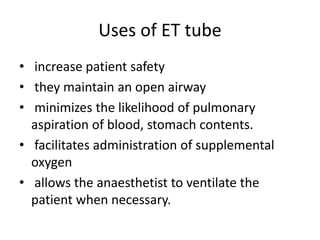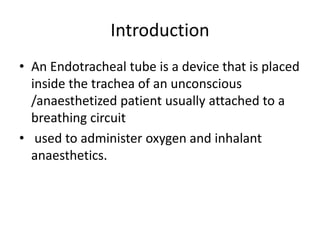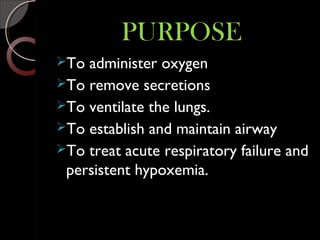Airway protection refers to preventing the lower airway ie. A combitube is a duel cuffed endotracheal airway used for blind endotracheal intubation.

Anatomy Of The Standard Endotracheal Tube Download Scientific Diagram
Anatomy of the Standard Endotracheal Tube Specialty Tubes in the Operating Room For Lung Isolation For Use in Maintaining a Clear Facial Surgical Field For.

. The endotracheal tube allows endotracheal intubation and mechanical ventilation as well as tracheal toilet. - allow for IPPV. Terms in this set 34 What is the purpose of endotracheal tubes.
Endotracheal tube are still considered the gold standard devices for securing and protecting the airway. Insert the tube over the epiglottis and between the vocal folds arytenoid carliage. Trachea bronchial tree and lung from aspiration.
- administration of inhalation anesthesia with reduced waste gas pollution. The presence of an ETT maintains airway patency permits oxygenation and ventilation allows for suctioning of secretions lowers the risk of aspiration of gastric contents or oropharyngeal secretions and facilitates the use of inhalation anesthetics. This item is usually used in the prehospital setting.
A neck plate extends from the sides of the outer tube and has holes to attach cloth ties or velcro strap around the neck. Reduced rish of saliva or regurgitated contents be inhaled. Cuffed endotracheal tubes seal the lower airway of at the cuff location in the trachea.
OralNasal Endotracheal Tubes Made from non-toxic PVC transparent soft and smooth With cuff High volume cuff provides positive tracheal wall seal Designed for use during short and long term ventilation and routine surgical procedures. The seal also prevents matter such as regurgitated gastric contents going into the trachea. The most popular and the cheapest nasal types disposable endotracheal tube GT014-100 endotracheal tube specification.
A double-lumen tube DLT is an endotracheal tube designed to isolate the lungs anatomically and physiologically1 Double-lumen tubes DLTs are the most commonly used tubes to provide independent ventilation for each lung. Most ETTs used in the operating room or critical care areas have standard design characteristics and features Markings along the length of the tube denote the number of centimeters from the tip of the tube helping. Anatomy of the Standard Endotracheal Tube.
Disposable less chances of infection Hypoallergenic since latex allergy is fairly comman. It serves to provide oxygen and inhaled gases to the lungs and protects the lungs from contamination such as gastric contents or blood. Endotracheal tube ett 3.
Endotracheal tubes ETT are an essential and familiar element of anesthesiology practice. ETTs are generally made of PVC although other materials include rubber silicone and metal. Foreign body in pharynx When gag reflex is present.
This seal prevents gases from leaking past the cuff and allows positive pressure ventilation. ET Tube for airway management for continuous ventilation on a ventilator and manual ventilation Description Used for oral intubation only intended for airway management. A commonly used tracheostomy tube consists of three parts.
4 A curved tip or coudé catheter is available for selective left main stem bronchial access. One-lung ventilation OLV or lung isolation is the mechanical and functional separation of the 2 lungs to allow selective ventilation of only. The simplicity of placement is the main advantage of.
3 Secure the ET tube in place using a piece of tie gauze or other similar material tied securely around the tube. Indications for intubation There are some separate indications for intubation and ventilation even though we usually see the two together. One for ET tubes approximately 56 cm 22 in which is sufficient to reach the main stem bronchi and one for tracheostomy tubes approximately 305 cm 12 in.
It is a valuable option in the management of upper and mid-tracheal lesions. Nasotracheal intubation- blind the insertion of an endotracheal tube through the nose and into the trachea. The endotracheal tube 2 has a cuff that is deflated and endotracheal tube 3 has a inflated cuff.
ENDOTRACHEAL TUBE ET Tube 2. The inflated portion forms a seal against the tracheal wall. Manufactured from clear polyvinyl chloride PVC.
In its simplest form the endotracheal tube is a tube constructed of polyvinyl chloride that is placed between the vocal cords through the trachea. General Anesthesia COMA CPR CARDIAC ARREST Respiratory failure Inability to ventilate the unconscious patient with conventional methods CONTRAINDICATIONS. Be careful not to insert the tube dorsally into the entrance to the esophagus.
Endotracheal tubes are curved tubes used for intubation Tubes were previously made up of latex indian rubber and those still available currently plastic tubes PVC are preferred because of following advantages. Endotracheal tube through the nose and into the stomach to relieve excess air from the stomach or to instill nutrients or medications. The outer cannula is the outer tube that holds the tracheostomy open.
The tube is passed without using a laryngoscope to view the glottic opening. Outer cannula with flange neck plate inner cannula and an obturator. The Montgomery T-tube is a device used as a combined tracheal stent and airway after laryngotracheoplasty.
Endotracheal tube Portex blue line suction above the cuff for the tracheal tube helps for the good results in oral intubation.

Endotracheal Intubation In Pets


0 Comments